Visiting Zion in December
Learn all about what to expect visiting Zion National Park in December
Updated: 10/28/22
Visiting Zion National Park in December gives you the opportunity to breathe in the fresh and crisp winter air, see incredible landscapes dusted with snow, and have space to enjoy it fully. The breathtaking scenery of Zion is even more remarkable as its walls are blanketed in a fresh layer of snow. There are many benefits to visiting Zion in December, as well as some drawbacks. If you can make it to Zion in December, you will have a fantastic experience and leave with an appreciation for the beauty and solitude of winter in the park.

Benefits of Visiting Zion in December
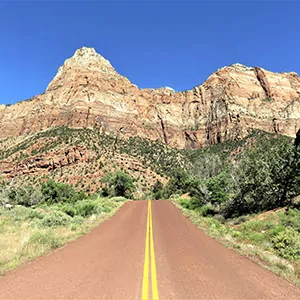 The biggest benefit of visiting Zion in December is the lack of crowds. Fewer crowds mean less irritation and more peace during the day. Many of the wildlife will be more willing to be out and about this time of year when there aren’t hundreds of people craning to see them. Fewer crowds mean no long lines for shuttle buses, no long waits for services, and more availability of accommodations. In winter, you’re more likely to find a place to stay that’s available within a few weeks of your travel date and at a discounted price compared to the summer. Winter is a season of peace and quiet in Zion.
The biggest benefit of visiting Zion in December is the lack of crowds. Fewer crowds mean less irritation and more peace during the day. Many of the wildlife will be more willing to be out and about this time of year when there aren’t hundreds of people craning to see them. Fewer crowds mean no long lines for shuttle buses, no long waits for services, and more availability of accommodations. In winter, you’re more likely to find a place to stay that’s available within a few weeks of your travel date and at a discounted price compared to the summer. Winter is a season of peace and quiet in Zion.
Another benefit of visiting in December is driving through the canyon in your own car. In spring, summer, and fall, private vehicle access is restricted past Canyon Junction to only those who are staying at the Zion lodge inside the park. This means that your only option for getting around Zion Canyon is the national park service shuttle buses. Although they do lighten the traffic, long lines, standing room only, and being tied to the bus schedule can be very annoying during these months. Personal cars are allowed through Zion Canyon from November to March, allowing you the freedom to see what you want to see on your own schedule. Take your time at the overlooks, trailheads, and museums as you genuinely get to explore on your own time, a luxury many visitors to Zion do not enjoy.
Perhaps the most obvious benefit of visiting in December is the breathtaking scenery. The walls and formations at higher elevations are often dusted with snow; many have icicles or even small frozen waterfalls hanging from them. The higher water levels combined with, the fewer people make January an excellent time for photography. You may have to stay a few days in order to get those snow-dusted pictures in contrast to the red rocks, as snow isn’t as common as you might think and can often melt through the day. But there is nothing like sunrise photography in Zion during the winter months. Make sure to put on your warm layers before you go out in the very cold mornings of January, but you won’t regret doing so.
Drawbacks of Visiting in December
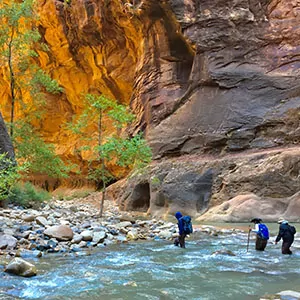 Perhaps the biggest drawback to visiting Zion National Park in December is trails may be closed due to snow or ice. Never attempt a closed trail due to ice or snow, even if you don’t see any on the ground. Conditions may worsen farther up in elevation, or the trail may be closed due to the danger of falling ice, which is just as dangerous as ice on the ground. Traction devices are recommended for trails at higher elevations and trails with shaded sections where snow and ice are less likely to melt. These devices, such as microspikes or crampons, go over your hiking boots much like chains go on car tires. Small spikes in the chains help give your feet more traction on ice and snow.
Perhaps the biggest drawback to visiting Zion National Park in December is trails may be closed due to snow or ice. Never attempt a closed trail due to ice or snow, even if you don’t see any on the ground. Conditions may worsen farther up in elevation, or the trail may be closed due to the danger of falling ice, which is just as dangerous as ice on the ground. Traction devices are recommended for trails at higher elevations and trails with shaded sections where snow and ice are less likely to melt. These devices, such as microspikes or crampons, go over your hiking boots much like chains go on car tires. Small spikes in the chains help give your feet more traction on ice and snow.
Zion’s winter weather isn’t exactly as much of a winter wonderland as some might think from the pictures. Snow that stays more than a few hours in Zion is relatively rare, and rain is also common in winter, melting away any snow. Rain may freeze overnight, causing icy conditions on the roads and trails, which is more dangerous– and less fun– than snow. Watch out for shady spots and sections of black ice on trails where the slippery spots are. Make sure to check out the trail conditions when planning what to do for the day.
Camping and backpacking are feasible in December but not recommended for those without winter camping experience. Freezing temperatures, whipping winds, snow storms, lack of drinkable water, and restrictions on fires all make camping in the backcountry very difficult in the winter. Dangers of flash floods still abound in winter with greater rainfall, so anyone hiking or camping in a slot canyon or near a stream should be aware of the dangers of these floods.
Things To Do In December
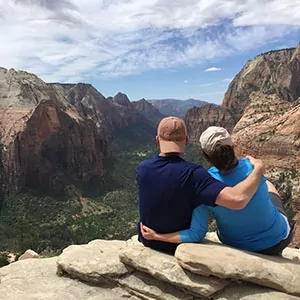
December is a great time to explore Zion without the crowds. The glistening snow in the canyon and on top of the towering cliffs makes the park very photography-friendly. Make sure to catch sunrise or sunset from Canyon Overlook Trail or Watchman Overlook Trail. Winter in Zion is wonderful for sightseeing, especially since you are able to drive through the canyon in your own car.
Many trails are open throughout the winter, giving you the space to enjoy the scenery without the crowds you’ll experience at other times of the year. You can read our list of Zion’s best trails for recommendations. Snowshoeing is a great option for trails at higher elevations; many companies in Springdale rent snowshoes.
The Watchman Overlook Trail is a fantastic hike that takes you to one of the most breathtaking views in the park. While this view is great any season, it is especially great in December if there’s snow on the ground, as it gives you a view of the entire Canyon and many of the cliffs surrounding it.
The Riverwalk trail is a great option for those who want to see a slot canyon but don’t have the cold water gear to plunge into the Narrows. This river sidewalk is generally flat and short and takes you to the trailhead of the Narrows, where the trail disappears into the Virgin River. Even though you’re not hiking in the river, the slot canyon still closes around you with towering cliffs on either side of the river.
Perhaps the most famous hike in the park, Angels Landing, is not usually accessible in winter due to ice and snow that make this already treacherous hike incredibly dangerous. Backpacking is also feasible but not recommended for those without winter equipment and experience. Check with a ranger or on the park website for more info on backpacking.
Wildlife viewing is a great activity to do in Zion during the winter months. You may have a chance to see large mammals such as bighorn sheep or deer concentrated in the valley or the canyon. The contrast of the animals against a snowy background is great for viewing and photography. Even though many of the small mammals and all of the reptiles will be in hibernation this time of year, much of the wildlife is still out and about, gathering in places of lower elevation for the warmer temperatures and more readily available food. Keep your eye out for predators such as gray foxes, coyotes, bobcats, and mountain lions. If snow is on the ground, watch for tracks and see if you can identify any of the creatures that passed by earlier.
If the weather takes a turn for the worse and you need some indoor activities to warm up, the visitor center has great interpretive exhibits and a 22 min park film that is informative and entertaining. The Zion Human History Museum is also a great option and has exhibits on Native American history, the effect that water has on the park, and much more.
Things to see in december
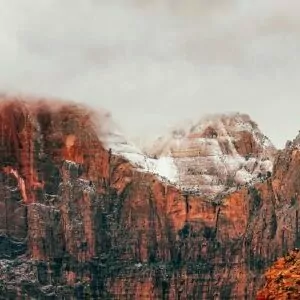 There are almost as many things to see in December as they are to do, and if you read the section above this, you know that’s a lot. Sightseeing is one of the most popular activities in December because some trails are closed, and you can see from inside your heated car. Snow-dusted cliffs, deep, gorgeous, rushing rivers, and desert oases are all things that you can see in Zion. Below, we’ve created a short list of some of the must-see sites in December in Zion, but make sure to do your own research to see what specifically piques your interest in the park.
There are almost as many things to see in December as they are to do, and if you read the section above this, you know that’s a lot. Sightseeing is one of the most popular activities in December because some trails are closed, and you can see from inside your heated car. Snow-dusted cliffs, deep, gorgeous, rushing rivers, and desert oases are all things that you can see in Zion. Below, we’ve created a short list of some of the must-see sites in December in Zion, but make sure to do your own research to see what specifically piques your interest in the park.
Kolob Canyons: While you won’t be fleeing here to avoid the crowds as you would be in summer, Kolob Canyons is simply stunning in December. Located in the northwest corner of the park, this less frequented but no less breathtaking area boasts ancient lava flows and volcanoes, slot canyons, and plenty of trails to choose from. About an hour’s drive from Zion, it is well worth a visit, but make sure that it hasn’t been closed for winter weather as they occasionally do not plow this section of the park.
Petroglyph Canyon: This little-known, unmarked canyon is one of the best-kept secrets in Zion. Located about 2.5 miles east of the Mount Carmel Tunnel on Highway 9, the park does not advertise this canyon in order to help maintain the ancient Native American petroglyphs that are etched into the walls. However, it is open to the public, and if you can find the trailhead, you can hike it. There is no obvious parking, so park where you can and walk back to the trailhead. If you do visit this area, be respectful and do not touch or make any markings on these ancient archaeological sites.
Angels Landing: Angels Landing is typically inaccessible in winter due to ice and snow, but that doesn’t mean you can’t take time to see it. This gigantic rock formation deserves some time to consider its massive size. If you want to see it from below, the Big Bend shuttle stop, which you’ll be able to drive to with your car, has a great view. If you feel like doing some hiking, the west rim trail or the Angels Landing Trail itself up to Scout Lookout are both great options for seeing this huge formation.
Zion Human History Museum: If the weather turns bad and you need some time indoors, the Zion Human History Museum is a must-see. The museum traces the two factors that have had the largest impact on this land: humans and water. Human history in Zion is traced back to the ancient Native American peoples, early pioneers, and settlers until it was designated as a national park. Many of the exhibits are also devoted to water’s impact on this landscape, both as a creator and destroyer.
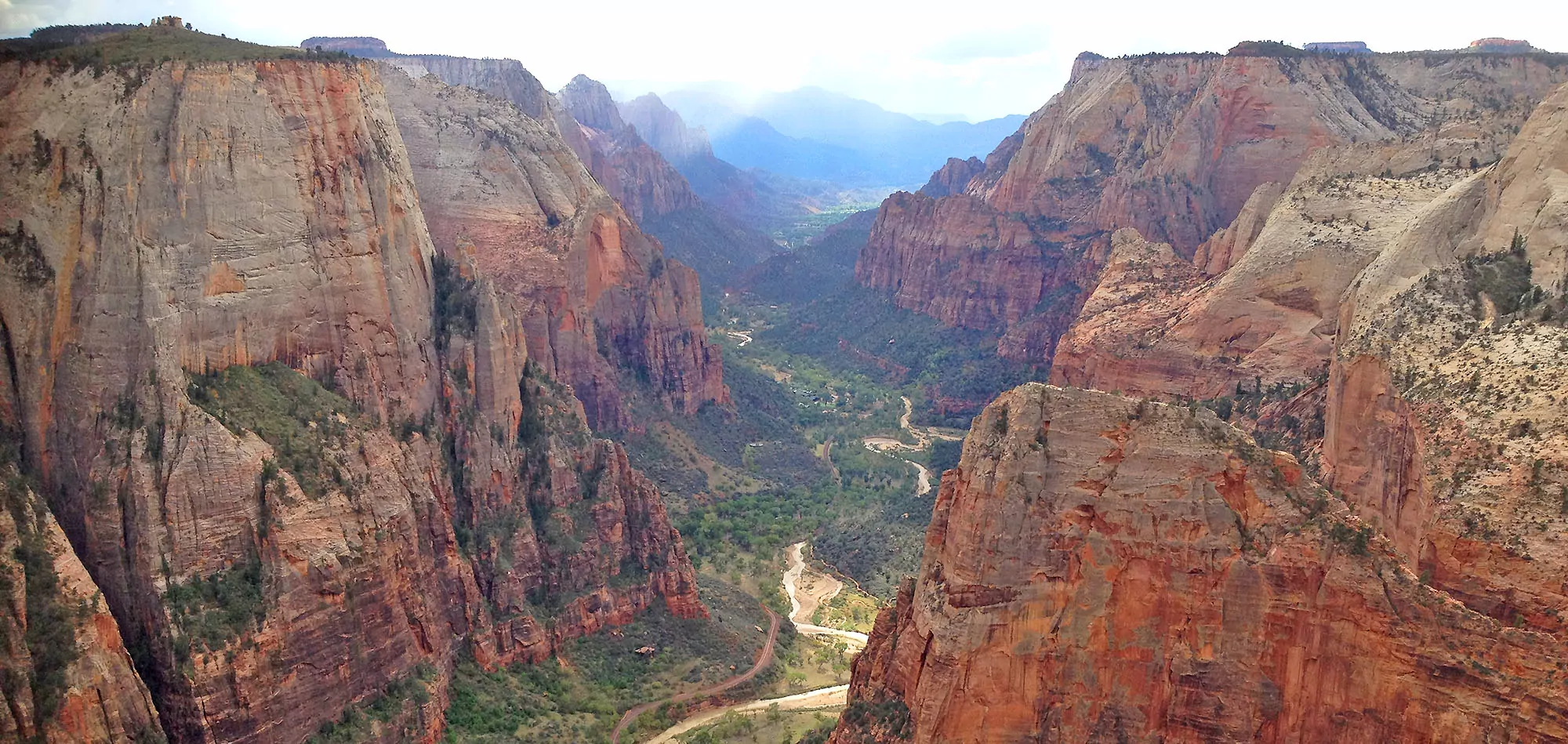
Hiking in December
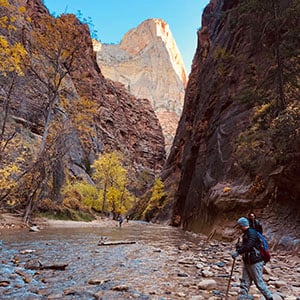 Hiking is a great activity in December because the crowds have thinned so immensely, and you might even have the trail to yourself. While roads are plowed during the winter, some hiking trails may be closed due to snow or ice, so read the current conditions for up-to-date information. Many of the shorter hikes will be available this time of year, such as the Riverwalk Trail or Watchman Overlook Trail.
Hiking is a great activity in December because the crowds have thinned so immensely, and you might even have the trail to yourself. While roads are plowed during the winter, some hiking trails may be closed due to snow or ice, so read the current conditions for up-to-date information. Many of the shorter hikes will be available this time of year, such as the Riverwalk Trail or Watchman Overlook Trail.
The Riverwalk trail gives visitors an opportunity to walk to the trailhead of the Narrows, where the path disappears into the river. This relatively flat and short trail offers a chance to hike along the river and see the narrowing of the slot canyon as the walls close in around the river.
Watchmen Overlook Trail hikes up to one of the most breathtaking vistas in the park. It is on the steeper side, but as well worth it. The Pa’rus Trail is another great option for a longer trail that is still flat. This paved walkway connects the Zion Visitor Center to Canyon Junction and is accessible to bikes, walkers, hikers, pets, and wheelchairs. Emerald Pools and the Canyon Overlook Trail are other great options for easier hikes, with the latter being a little bit steeper than the others.
Unfortunately, some of the more famous trails in the park may be inaccessible due to the weather and the snow. We do not recommend doing this winter hike unless you are experienced.
Backpacking in december
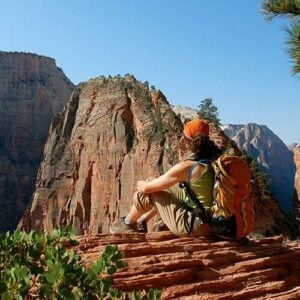 Backpacking in December in Zion is not for the faint of heart or the inexperienced, as this activity can be treacherous if very rewarding. Zion is a world-class backpacking destination, as the landscape you are hiking through is genuinely spectacular. Zion has different and stricter regulations than other national parks on their backpacking policies, so it’s important to understand the rules before you set out. The park limits group size and campsites, so you must reserve each backcountry campsite with a separate permit. This means that you will have less flexibility in the backcountry to change plans. Zion also has strict regulations on human impact on the wilderness that includes a pack-it-in, pack-it-out policy that includes all trash as well as human waste.
Backpacking in December in Zion is not for the faint of heart or the inexperienced, as this activity can be treacherous if very rewarding. Zion is a world-class backpacking destination, as the landscape you are hiking through is genuinely spectacular. Zion has different and stricter regulations than other national parks on their backpacking policies, so it’s important to understand the rules before you set out. The park limits group size and campsites, so you must reserve each backcountry campsite with a separate permit. This means that you will have less flexibility in the backcountry to change plans. Zion also has strict regulations on human impact on the wilderness that includes a pack-it-in, pack-it-out policy that includes all trash as well as human waste.
A backpacking trip through the Narrows is possible, and there are 12 designated sites along the canyon. Kolob Arch via La Verkin Creek Trail is a great option if Kolob Canyon is accessible. Backpacking any trail during the winter will be more difficult than it would be in the warmer months due to the freezing temperatures, whipping winds, snow storms, lack of drinkable water, and route finding. Four-season tents, 0° sleeping bags, and microspikes or crampons are a must for any winter backpacking trip in Zion.
Weather in December
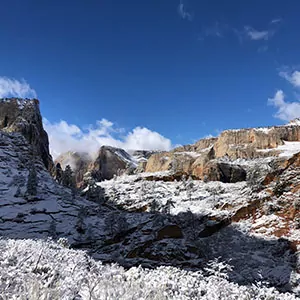 Weather in Zion during the month of December is typically cold and wet. Almost half of the yearly precipitation in Zion Canyon occurs between December and March. The average temperature for Zion Canyon is a high of 53 and a low of 30 degrees Fahrenheit (12/-1 degrees Celsius). In Kolob Canyons, the average temperature is a high of 50 and a low of 26 degrees Fahrenheit (10/-3 degrees Celsius). On average, it rains or snows for six days in December.
Weather in Zion during the month of December is typically cold and wet. Almost half of the yearly precipitation in Zion Canyon occurs between December and March. The average temperature for Zion Canyon is a high of 53 and a low of 30 degrees Fahrenheit (12/-1 degrees Celsius). In Kolob Canyons, the average temperature is a high of 50 and a low of 26 degrees Fahrenheit (10/-3 degrees Celsius). On average, it rains or snows for six days in December.
Note that it either rains or snows in December. This fluctuation across the freezing point can cause some unfortunate weather events. First, any snow that does fall isn’t likely to stick around for more than a few hours. This is because it probably snowed overnight and will likely melt the next morning with the sun’s heat. If you’re looking to get some of those gorgeous winter pictures and you see snow in the forecast overnight, make sure to get up early and get the pictures before it melts. On the other hand, rain that falls during the warmer part of the day is likely to freeze overnight when the temperature drops. This can cause icy conditions on roads and trails, which is much less fun and far more dangerous than snow.
Wildlife in december
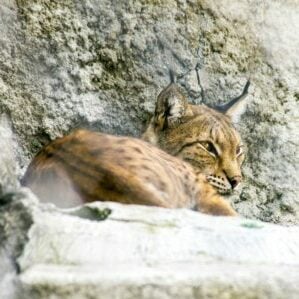 While it may seem unlikely that wildlife viewing in Zion would be a popular activity in December, winter is one of the best seasons to view wildlife in the park. Because of the cold temperatures and snow at higher elevations, many of the park’s larger mammals come down to the valleys and canyons for the warmer weather and the more readily available food. Mule deer and bighorn sheep both congregate at the lower elevations where visitors often see them. Not only are these animals in more readily accessible places to see in winter, but the lack of crowds makes them more likely to stick around if you pull off the road to take pictures from your car or stop along your hike to snap a photo from the trail.
While it may seem unlikely that wildlife viewing in Zion would be a popular activity in December, winter is one of the best seasons to view wildlife in the park. Because of the cold temperatures and snow at higher elevations, many of the park’s larger mammals come down to the valleys and canyons for the warmer weather and the more readily available food. Mule deer and bighorn sheep both congregate at the lower elevations where visitors often see them. Not only are these animals in more readily accessible places to see in winter, but the lack of crowds makes them more likely to stick around if you pull off the road to take pictures from your car or stop along your hike to snap a photo from the trail.
Because of the congregation of these animals, predators also congregate in the lower valleys where their prey is. Gray foxes, coyotes, bobcats, and mountain lions all inhabit the park. While it is very rare to see either of the feline members of the predator family, you might be able to see their tracks in fresh snow overnight as they are nocturnal hunters. Both the foxes and coyotes are more willing to let themselves be seen by visitors, although usually around dawn or dusk, scurrying across the road or lurking in a campground.
Other animals that live in the park, such as porcupines or beavers, don’t hibernate in the winter but are seldom seen as they spend much of their time in their dens or lodges. Of course, many of the small mammals and all of the reptiles will be hibernating for the winter, but avian residents in the park are still very active. The California condor, the largest bird native to North America, has a presence in Zion. With a wingspan that can reach up to 9 1/2 feet, these birds are truly majestic to see in flight. If you’re in one of the slot canyons, keep your eye out for nesting Mexican spotted owls. These monogamous birds love the cool temperatures that remain in the slot canyons throughout the year and can often be seen feeding at dawn or dusk. If you’re interested in seeing a specific animal, ask a ranger about where the best place would be to see one or what has been caught lately on remote camera traps.
Recommended wildland trips in december
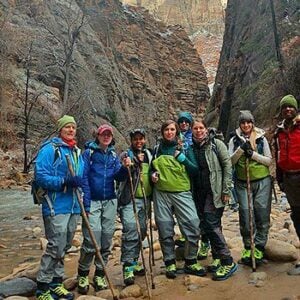 Planning a trip to a national park can be stressful as you try to keep up with the weather, current conditions, where to stay, and what to do. Some people enjoy planning out every last detail of the vacation, but others don’t have the time to do so and end up losing time at the park deciding what to do. But you can bypass all that headache by booking a trip with Wildland Trekking and letting one of our expert guides show you around. Whether you want to camp with us, stay at a lodge on an inn-based tour, or spend a day with one of our expert guides, we have something for you. Feel free to check out all the trips we offer in Zion, but here are a few we especially recommend for December.
Planning a trip to a national park can be stressful as you try to keep up with the weather, current conditions, where to stay, and what to do. Some people enjoy planning out every last detail of the vacation, but others don’t have the time to do so and end up losing time at the park deciding what to do. But you can bypass all that headache by booking a trip with Wildland Trekking and letting one of our expert guides show you around. Whether you want to camp with us, stay at a lodge on an inn-based tour, or spend a day with one of our expert guides, we have something for you. Feel free to check out all the trips we offer in Zion, but here are a few we especially recommend for December.
Zion in a Day Private Tour: Because of the density of national parks in this area of the country, many people only leave a single day to explore Zion. On this tour, a single day will give you a taste of what Zion offers. You can expect 3 to 4-day hikes depending on what your group wants, in distinct areas of the park so that you’ll know where you want to come back to and explore more. All-inclusive with top-of-the-line backpacks and trekking poles, crampons for your hiking boots, trail snacks, a picnic lunch, and an expert local guide, you won’t want to miss out on this fantastic day in Zion.
Zion and Bryce Four-Day Tour: Zion and Bryce Canyon are two of Utah’s most fantastic national parks, so why not combine them into a single spectacular trip? This four-day, inn-based tour will allow you to experience the best of each park. Stroll through the hoodoos, see the slot canyons, and go on fantastic day hikes before returning to comfortable lodges in the evening and excellent dining. All-inclusive with your meals, local transportation, accommodations, and much of your gear included, this is a great trip for those wanting to see both Zion and Bryce.
Snow Canyon Private Day Tour: While it’s not technically in Zion National Park, the nearby Snow Canyon is almost as spectacular as Zion and is well worth visiting. See this area’s ancient lava flows, deep gorges, and towering red rock cliffs on this all-inclusive, private day tour. Great as a day trip during a longer stay in Zion or just as a stop as you pass through, our expert guides will ensure that you experience the best this area offers.
Join a Guided Hiking Adventure
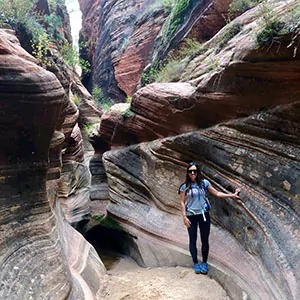 Zion National Park is home to some of the world’s most epic and fantastic hiking vacations. Wildland Trekking offers trips with the best of Zion: canyons, views, wildlife, solitude, adventure, and fascinating natural and cultural interpretation.
Zion National Park is home to some of the world’s most epic and fantastic hiking vacations. Wildland Trekking offers trips with the best of Zion: canyons, views, wildlife, solitude, adventure, and fascinating natural and cultural interpretation.
Guided Zion treks are all-inclusive, which covers permits; local transportation (excluded on specific tours); meals; equipment; safety systems, and professional hiking/wilderness guides; all of which allows visitors to maximize their time in Zion and focus entirely on enjoying the Park.
ZION ADVENTURE TOURS
- INN-BASED HIKING PACKAGES: these tours are all-inclusive packages with lodging, amazing daily hikes, expert guides, meals, transportation and more!
- ZION CAMPING TOURS: camping-based hiking packages provide all-around hiking experiences of Zion on wonderful outdoor vacations.
- ZION DAY HIKE TOURS: maximize your day in Zion on a fully guided, award-winning hiking tour on one of the Park’s best trails.
- ALL UTAH HIKING TOURS: check out a full list of Utah offerings, which include Bryce Canyon, the North Rim, Arches, Canyonlands and more.
- UTAH BACKPACKING TRIPS: explore options for discovering Utah on an all-inclusive backpacking trip with expert guides and mind-blowing scenery.





